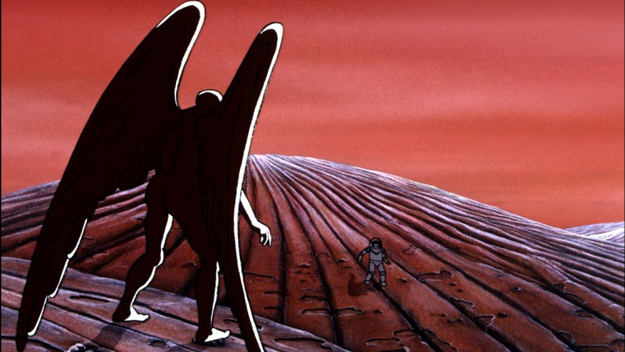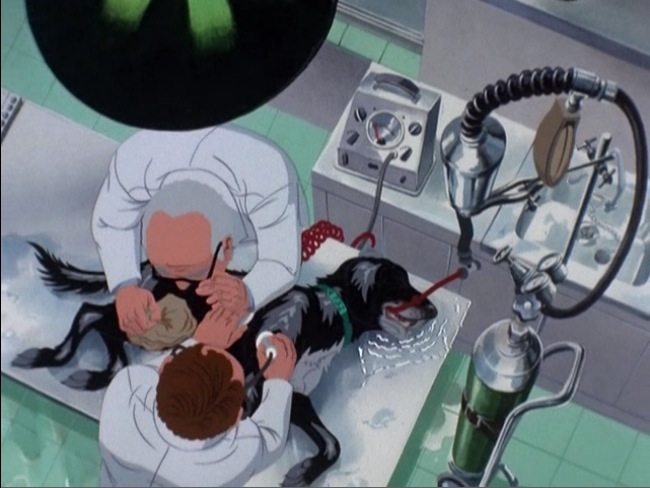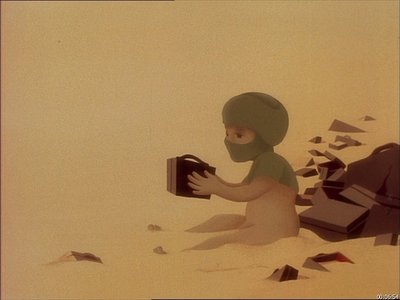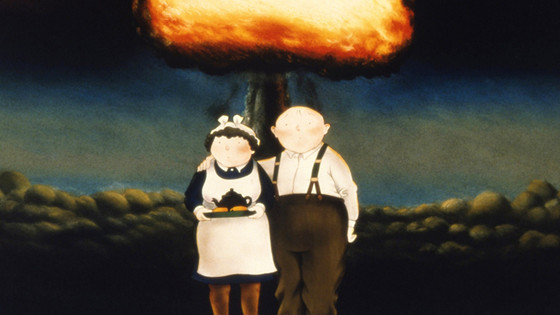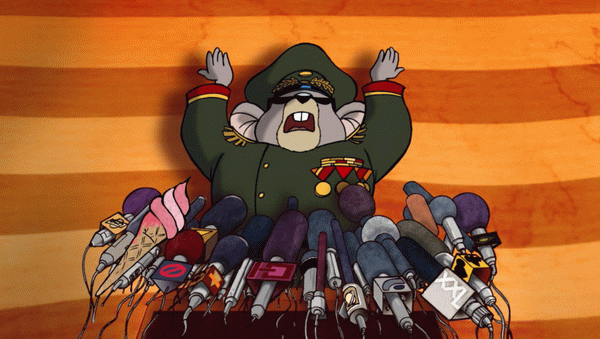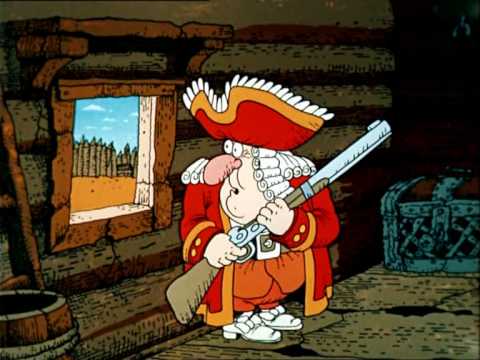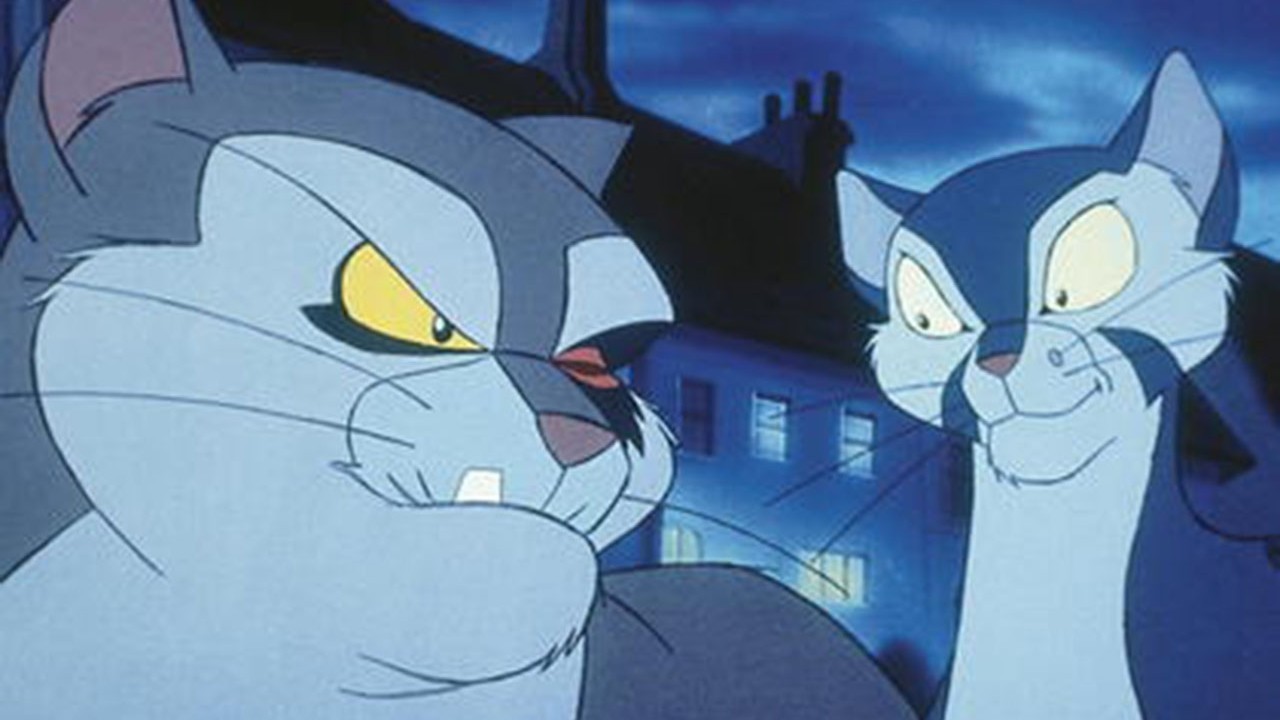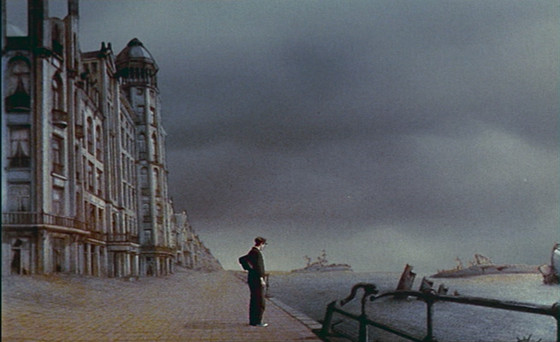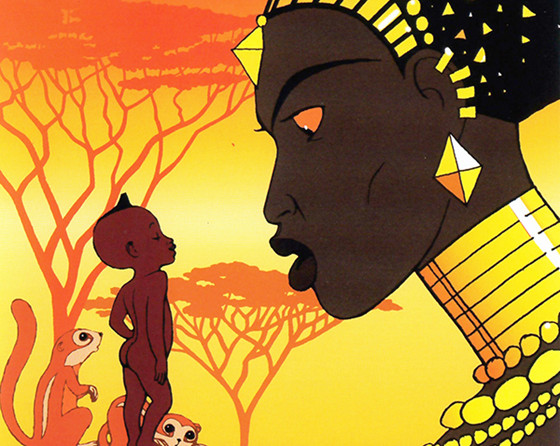21. Time Masters (1982, France) Dir. by Rene Laloux
This science-fiction feature is worth viewing for its looks only. But what looks those are! Co-written and designed by Moebius himself, it invites into some of the most phantasmagoric worlds, inhabited by appropriately weird and striking creatures.
The slightly languid plot and simply-drawn human characters take a firm back seat to some of the best graphic design ever animated. Moebius revolutionized pop-art and raised the bar, and here he does the same for cel animation.
Other works: besides this and Fantastic planet, see Gandahar (1987).
22. Plague Dogs (1982, UK) Dir. by Martin Rosen
Rosen’s other contribution to animation, it doesn’t have Watership Down’s cult status mainly due to shaky distribution. Otherwise, all the elements are there-source novel by Richard Adams, the cruel and menacing world, an escape in search of better life, or, indeed, just a life.
Two dogs escape from the laboratory where they have been subjected to inhumane tests, and seek freedom and warmth, the things they have been denied all their lives. Again, the artwork is memorable and serves the story well. The ending has been changed from the source novel, but here it actually manages to add more moody ambiguity.
23. Gwen, or The Book of Sand (1985, France) Dir. by Jean-Francois Laguionie
Post-apocalyptica is a rewarding theme for serious animation. Laguionie presents the desert world as a mix of Nicholas Roerich and Salvador Dali in its look. This is a road (or off-road) film, where the journey itself is the plot, and the discoveries the heroes make along the way. As inhospitable as this desert world may seem, you’ll be glad you visited it.
Other works: as good as Gwen is, the short Rowing Across the Atlantic (1978) is more striking and powerful. His latest feature is The Painting (2011).
24. When the Wind Blows (1986, UK) Dir. by Jimmy Murakami
Continues the fine British post-nuclear tradition that began so well with War Game (1965), and got such a boost with 1984’s Threads. There is a reason Brits might be so into the “what-if” scenarios. Their geography puts them exactly between Moscow and Washington, resulting in the knowledge that when the zero hour comes, they are unlikely to leave unscathed.
This adaptation of the graphic novel by Raymond Briggs tells a story of a sweet elderly Sussex couple. Upon hearing the government’s warning, James constructs a makeshift shelter (Hilda, his wife, is more concerned of him bringing dirt into the house and what curtains to use). The shelter helps them to survive initial shock wave.
Their expectations are stuck in the WWII times of their youth. But they emerge from the shelter not to face the brave new world, but a smoking corpse of the world they know. And then it gets darker. When Roger Waters writes most of your soundtrack, hope is a four letter word.
Not a happy film, but poignant and thoughtful, in addition to being very well made artistically. You’ll empathize with the protagonists, especially if you have grandparents and elderly parents. And David Bowie’s titular song will acquire a whole new meaning for you.
25. Cat City (1986, Hungary) Dir. by Bela Ternovszky
Another fine export from Hungary. Cats and mice have a long history of opposition-here they are given guns and other weapons to use on each other. It’s a biting parody on the spy genre. A mouse super-agent travels to Tokyo to obtain info on an invention that can potentially turn the tide of war. He is pursued by the cat armed forces and a quartet of hired goons-rats.
Meanwhile, his decoy is lost in the jungle, but befriends a tribe of very musically inclined vampire bats. All leading to the final showdown. As zany and funny as this spy musical is, it’s not for children under 12 (unless you want to explain why the kitty just machine-gunned a crowd of mousies-and vice-versa). But for those who enjoy a good parody, it’s a treat.
Other works: Modern Sports Coaching (1970) is a hilarious collection of sport-related gags (mostly centering on unconventional coaching methods, such as shark in the pool, or tennis with grenade). Let Us Keep a Dog (1975) is also worthy.
26. Treasure Island (1988, USSR) Dir. by David Cherkassky
The Odessa-born director’s most enduring work, it is a hyperhilarious adaptation of Robert Louis Stevenson’s pirate tale, with musical numbers to boot.
The parody here runs wild, as the characters couldn’t be more different than in the book, from nerdy but positive and surprisingly strong and martial-arts capable Jim, to perennially laughing (even when dispensing dire diagnosis) Dr. Livesey, to reptilian and slick Long John Silver.
Cherkassky lets go of all the reins when it comes to absurd humor (the sequence when a pirate uses a ship cannon as a machine gun has to be seen), and there is more-each character is preceded by a brief police file bio (“Cpt. Smollet. An old sailor and soldier who always tells the truth and suffers because of it.
Personality: terrible. Not married”) and the animated action scenes are interspersed with song and dance numbers by an appropriately named rock group “Grotesque”. For colorful action and laughter-inducing entertainment, seek no further. Yo-ho-ho, and a bottle of fun.
Other works: David Cherkassky made two more feature-series in similar style at the Kiev studio-The Adventures of Captain Vrungel (1976-1977) and Doctor Aybolit (1984).
27. Alice (1988, Czechoslovakia) Dir. by Jan Svankmajer
This is more Nightmareland than Wonderland. Svankmajer, an extremely influential stop-motion animator and artist, creates a fascinating but menacing universe and thrusts the titular heroine into the thick of it. He takes Carroll’s immortal absurdist tale and adds darker shades to it.
All the sights and sounds combine to give an eerie but unforgettable experience-the creaking of rusty doors, the rustle of sawdust, the frequently disintegrating white rabbit, the Blue Caterpillar that forms itself out of dentures and an old sock, the skulls and skeletons that come to life, etc. Alice herself changes from a human character to a doll and back. An experience that is never forgotten once seen.
Other works: Svankmajer began by making highly individual and unique puppet films-A Game with Stones (1965), Punch and Judy (1969), The Flat (1968), Jabberwocky (1971), The Fall of the House of Usher (1980), Dimensions of Dialogue (1982), Darkness/Light/Darkness (1989), The Death of Stalinism in Bohemia (1990), Food (1992)-all are unforgettable.
After Alice, his features usually combine live actors with animated sequences-Faust (1994), Conspirators of Pleasure (1996), Little Otik (2000), Lunacy (2005), Surviving Life (2010). His 2015 film Insects is highly anticipated. Welcome to a strange world. You’ve been warned.
28. Felidae (1994, Germany) Dir. by Michael Schaack
“Private detectives are barometers of morality”, said another fictional detective. This concept is true in this striking German neo-noir. This adaptation of Akif Pirincci’s novel is colorful, intense-and often very disturbing. The hero is a detective-who’s also a cat. After moving to a new home with his owner, he encounters gruesome killings of cats, and sets to investigate with determination that’s actually more dogged than feline.
This film is not for small children-cats and people are killed, and even the good characters behave in a base way by both human and animal standards. Unlike the Disney universe, here a meeting between a tomcat and a kitty results not in cute nose rubbing but in a straightforward and rough copulation. For those who see it-the story is rewarding and coherent, and the noir look fits it perfectly.
29. Taxandria (1994, Belgium) Dir. by Raoul Servais
Alain Robbe-Grillet is not an easy writer, either to read or adapt for screen, but very rewarding for those who do brave his experimental style. It’s telling that usually he had to direct his own works. Two exceptions stand out-Alain Resnais’ Last Year in Marienbad, a seminal film, and this partially animated outing.
In Raoul Servais, Robbe-Grillet found a perfect collaborator. Servais has long developed a unique visual style, called servaisgraphie, where live actors are organically integrated into animated worlds.
Here, it’s used to tell a story of a young prince who arrives at a seaside resort with his tutor and gets an entry into the mysterious Taxandria, ruled repressively by the Two Princes and their complex police machine. Dark at times, but mostly a humorously Kafkaesque world. A perfectly weird vacation destination.
Other works: Servais is known for his unique style, and his works are not to be missed. The most famous of these is 1979’s Harpya.
30. Kirikou and the Sorceress (1998, France/Belgium/Luxembourg) Dir. by Michel Ocelot
Michel Ocelot’s gift is to combine style and content perfectly. This is probably his best known work, a tale of coming of age and overcoming difficulties, set in Africa. Using digital ink and paint, Ocelot creates an organic and visually arresting land of people and beasts, spirits and magic. The message is not didactic, we really see how Kirikou progresses and grows.
Other works: Ocelot made a number of similarly positive and artistic films, with looks ranging from silhouette to computer graphics. Tales of the Night (1992), Princes and Princesses (2000), Kirikou and the Wild Beasts (2005), Azur & Asmar (2006), and many more.
